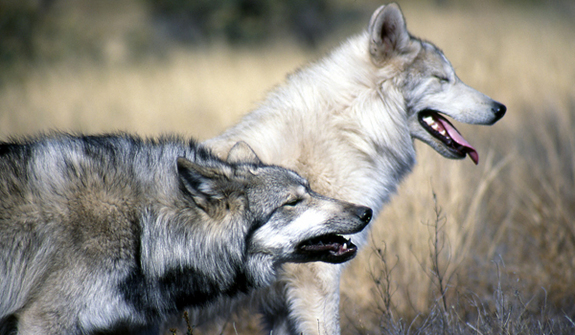24 Ways Wolves are Different from Dogs

Although both the animals are similar on a genetic level, these two cousin brothers are quite different to each other. DNA sequencing and genetic drift studies have proved that dogs share a common origin with wolves. Where the dog is considered as man’s best friend, wolves have the reputation to be feral beasts since long time. Before we discuss the points of differences between these two, lets me illustrate the similarities between these wolves and dogs.

Both animals develop the sense of smell at two weeks.
They develop the sense of hearing at four weeks and sense of vision by six weeks.
The difference starts with their socialization. Socialization of these two animals starts at different stages of their lives. Socialization of dogs includes their introduction to humans while wolves start exploring their wild world. Dogs and wolves vary at the following points:
- Unlike wolves, dogs have established themselves as domesticated animals which are capable of making a close relation with humans.
- Wolves are placed in family ‘Canis Lupus’ and dogs are placed in family ‘Canis familiaris’ of Kingdom Animalia.
- Wolf has a large body as compared to most of dogs.
- Muzzle of wolf is longer than that of dogs.
- Wolves have longer legs, larger feet and wider cranium than dogs.
- Dogs are not physically as powerful as wolves.
- Teeth of wolves are adapted for hunting. Unlike dogs, wolves have stronger molar teeth that help him to crush large bones. Wolves also have special teeth for holding the prey. Teeth of wolves are more curved and thicker than dogs.
- Dogs can also survive on kibble as well as commercial dog food while wolves are carnivores.
- Wolves are supposed to be cleverer than dogs.
- Unlike dogs, wolves are more aware about their surroundings.
- Wolf howls while dog barks.
- Wolves love to be in accompanied by other wolves while dogs are not used to living in groups.
- Dogs and wolves also vary in their sexual behaviors. Female wolf comes into heating period for once in an year while female dog get into heating period twice in an year.
- Skeletal structure of dogs and wolves also varies. A wolf has a large head and narrow chest while dogs don’t have this structure. Structures of dogs vary from breed to breed. Generally, dogs have wide chest and hips. Large head of wolves also contributes to their intelligence.
- A wolf marches while a dog trots. Wolves can pace due to their longer legs and larger feet.
- Wolves are natural hunters while dogs, after spending hundreds of years with humans, are different to their wild counterparts when it comes to hunting.
- Dogs and wolves also vary in the color of their eyes. Most of dogs have brown or blue eyes while wolves have eyes with varying shades of yellow color.
- Unlike dogs, wolves do not have a sharp defined tail.
- The color of wolf’s fur changes as they mature. There is no such change observed in dogs.
- Unlike dogs, wolves don’t have pink/black, pink reddish noses.
- Male dogs become sexually mature at 6-8 months of age while wolves are sexually immature until 22 months of age.
- Wolves have smaller, rounder, thicker, well furred ears while most dogs have larger, pointier and thinner ears.
- Wolves do not have sweat glands in their paws. Dogs have sweat glands in their paws.
- Most dogs shed twice a year while wolves generally shed once in a year.
One trait which both the animals share is protectiveness; dogs are protective towards their owner and wolves towards their pack mates. Detailed study of their behavior and physically appearance will bring more interesting contrasts between these two. You can share points of similarity or differences between these kins, in case we missed any.

![]() +91-8744012053
+91-8744012053
.png)


![]() +91-8744012053
+91-8744012053
.png)

